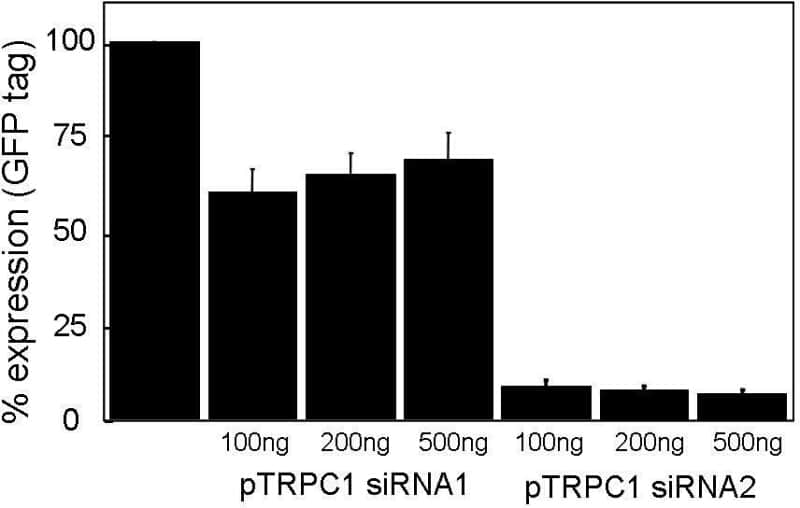There are seven structurally related canonical type transient receptor potential channels in mammalian cells (TRPC1-7), although TRPC2 is a pseudogene in man. The genes encoding these channels are differentially expressed in different cell types with many cells expressing at least 3 of the subtypes. Because of this heterogeneity of expression and the likelihood that channels may be formed of heteromultimers, the relative contribution of each individual channel subtype to calcium influx has been difficult to assess. To address this question we have attempted to generate small interfering RNAs (siRNAs) to serially deplete both individual, and combinations of TRPC channels. These siRNAs form a hairpin structure which are cleaved to generate 23 base duplexes. So as to provide an initial analysis of the efficacy and specificity of these siRNAs, we have cloned cDNAs encoding individual TRPC channels with carboxy terminal green fluorescent protein (GFP) tags. These cDNAs have been transiently transfected into HEK-293 cells and the correct membrane targeting has been assessed by imaging microscopy. We have begun to analyse the efficacy of each siRNA both by fluorescent activated cell sorting (FACS) and western blotting. At least two different siRNAs have been tested for each TRPC channel. TRPC1-GFP expression was repressed by 40% with TRPC1-siRNA1 and by over 90% with TRPC1-siRNA2 (Fig. 1; n=7). siRNAs directed against the remaining channels were partially effective when used individually, yielding repression ranging from between 15 and 53%. TRPC1-siRNA2 had no effect on expression of the other TRPC-GFP fusions indicating specificity for the desired target. We are currently testing the effects of use of combination of the partially active siRNAs as well as testing additional hairpins. Knockdown of endogenous TRPC mRNA will be tested using these siRNAs and functional experiments on calcium handling will also be carried out in cell lines and primary cultured airway smooth muscle cells.
King's College London (2005) J Physiol 565P, PC71A
Communications: Development of short interfering RNAs (siRNA) for knock-down of TRPC channels in human cells
Shaifta, Yasin M; Snetkov, Vladimir A; Santis, George ; Cousins, David J; Lavender, Paul ; Ward, Jeremy PT;
1. King's College London, London, United Kingdom.
View other abstracts by:
Figure 1. TRPC1 over-expression and knock-down with siRNAs. Amount of plasmid per 5x105 cells shown below bars. Data derived from Western blots against GFP tag and shown as mean ± SEM n=7.
Where applicable, experiments conform with Society ethical requirements.

